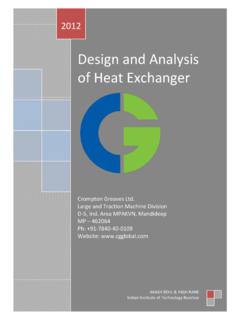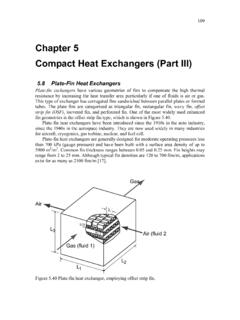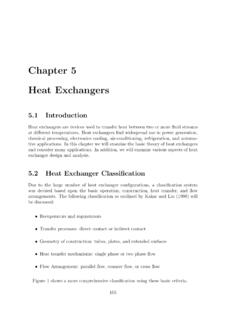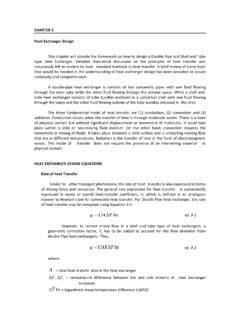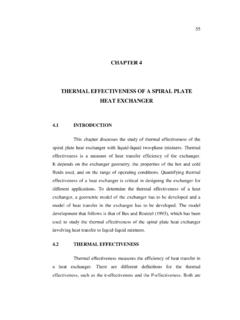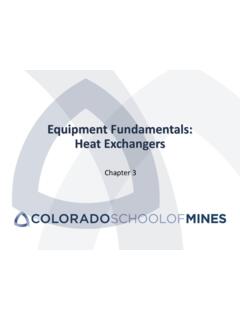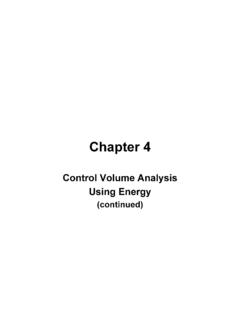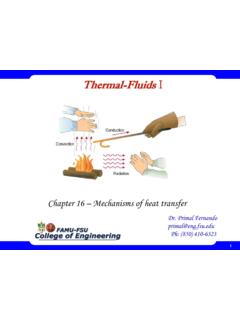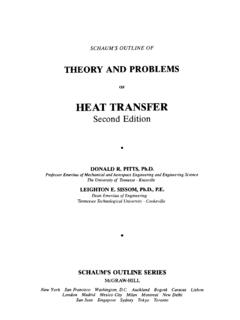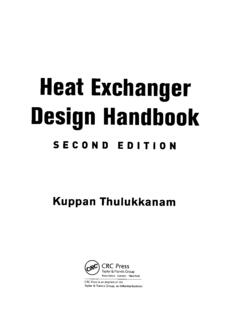Transcription of CHAPTER 15
1 CHAPTER 15 EQUIPMENT FOR MOLTEN-SALT REACTOR heat -TRANSFERSYSTEMS*The equipment required in the heat -transfer circuits of a molten-saltreactor consists of the components needed to contain, circulate, cool, heat ,and control molten salts at temperatures up to 1300 F. Included in suchsystems are pumps, heat exchangers, piping, expansion tanks, storagevessels, valves, devices for sensing operating variables, and other for the fuel and blanket salts differ from standard centrifugalpumps for operation at high temperatures in that provisions must be madeto exclude oxidants and lubricants from the salts, to prevent uncontrolledescape of salts and gases, and to minimize heating and irradiation of thedrive motors.
2 heat is transferred from both the fuel and the blanket saltsto sodium in shell-and-tube heat exchangers designed to maximize heattransfer per unit volume and to minimize the contained volume of salt, es-pecially the fuel piping is used, where possible, to minimize flaws. Thermal ex-pansion is accommodated by prestressing the pipe and by using expansionloops and joints. Heaters and thermal insulation are provided on all com-ponents that contain salt or sodium for preheating and for maintainingthe circuit' at temperatures above the freezing points of the liquids andto minimize heat losses. Devices are provided for sensing flow rates, pres-sure, temperatures, and liquid levels.
3 The devices include venturi tubes,pressure transmitters, thermocouples, electrical probes, and floats. Inertgases are used over free-liquid surfaces to prevent oxidation and to applyappropriate base pressures for suppressing cavitation or moving liquid orgas from one vessel to deviations from standard practice required to adapt the variousconiponeiit to the molten-salt system are discussed below. The schematicdiagram of a molten-salt heat -transfer system presented in Fig. 15-1 in-dicates the relative positions of the various components. For nuclear op-eration, an off-gas system is supplied, as described in CHAPTER 17.
4 Thevapor condensation trap indicated in Fig. 15-1 is required only on systemsthat contain ZrF4 or a comparably volatile fluoride as a component of themolten salt.*By 11. W. Savage, W. F. Boudreau, E. J. Breeding, ". G. Cobb, W. B. Mc-Donald, Metz, and E. pumps with radial or mixed-flow types of impeller have beenused successfully to circulate molten-salt fuels. The units built thus farand those currently being developed have a vertical shaft which carriesthe impeller at its lower end. The shaft passes through a free surface ofliquid to isolate the motor, the seals, and the upper bearings from directcontact with the molten salt.
5 Uncontrolled escape of fission gases or entryof undesirable contaminants to the cover gas above the free-liquid surfacein the pump are prevented either by the use of mechanical shaft seals orhermetic enclosure of the pump and, if necessary, the motor. Thermal andradiation shields or barriers are provided to assure acceptable temperatureand radiation levels in the motor, seal, and bearing areas. Liquid coolingof internal pump surfaces is provided to remove heat induced by gammaand beta principles used in the design of pumps for normal liquids are applic-able to the hydraulic design of a molten-salt pump. Experiments haveshown that the cavitation performance of molten-salt pumps can be pre-dicted from tests made with water at room temperature.
6 In addition tostresses induced by normal thermal effects, stresses due to radiation mustbe taken into account in all phases of pump shown in Fig. 15-2 was developed for 2000-hr durability atvery low irradiation levels and was used in the Aircraft Reactor Experi-ment for circulating molten salts and sodium at flow rates of 50 to 150 gpm,at heads up to 250 ft, and at temperatures up to 1550 F. These pumpshave been virtually trouble-free in operation, and many units in additionto those used in the Aircraft Reactor Experiment have been used in devel-opmental tests of various components of molten-salt bearings, seals, shaft, and impeller form a cartridge-type subassemblythat is removable from the pump tank after opening a single, gasketedjoint above the liquid level.
7 The volute, suction, and discharge connec-tions form parts of the pump tank subassembly into which the removablecartridge is inserted. The upper portion of the shaft and a toroidal areain the lower part of the bearing housing are cooled by circulating oil. Heatlosses during operation are reduced by thermal all the units built thus far nickel-chrome alloys have been used inthe construction of all the high-temperature wetted parts of the pump tominimize corrosion. The relatively low thermal conductivity and highstrength of such alloys permitted close spacing of the impeller and bearingsand high thermal gradients in the loads are carried at the top of the shaft by a matched pair of pre-loaded angular-contact ball bearings mounted face-to-face in order to pro-vide the flexibility required to avoid binding mud to accommodate thermaldistortions.
8 Either single-row ball bearings or a journal bearing can beused successfully for the lower upper lubricant-to-air and the lower lubricant-to-inert-gas sealsare similar, rotary, mechanical face-type seals consisting of a stationarygraphite member operating in contact with a hardened-steel rotating mem-ber. The seals are oil-lubricated, and the leakage of oil to the process sideis approximately 1 to 5 This oil is collected in a catch basin andremoved from the pump by gas-pressure sparging or by accumulation of some 200,000 hr of relatively trouble-free test op-eration in the temperature range of 1200 to 1500 11with molten salts andliquid metals as the circulated fluids has proved the adequacy of this basicpump design with regard to the major problem of thermally induced dis-tortions.
9 Four different sizes and eight models of pumps have been usedto provide flows in the range of 5 to 1500 gpm. Several individual pumpshave operated for periods of 6000 to 8000 hr, consecutively, without Improvements desired for power reactor fuel pump. The basicpump described above has bearings and seals that are oil-lubricated andcooled, and in some of the pumps elastomers have been used as seals be-tween parts. The pump of this type that was used in the ARE was de-signed for a relatively low level of radiation and received an integrateddose of less than 5 X 108r. Under these conditions both the lubricants andelastomers used proved to be entirely fuel pump for a power reactor, however, must last for many radiation level anticipated at the surface of the fuel is 105tolOf'r/ and gamma-emitting fission gases will permeate all available gasspace above the fuel, and the daughter fission products will be depositedon all exposed surfaces.
10 Under these conditions, the simple pump describedabove would fail within a few thousand improvement in the resistance of the pump and motor toradiation can be achieved by relatively simple means. Lengthening theshaft between the impeller and the lower motor bearing mid inserting addi-tional shielding material will reduce the radiation from the fuel to a lowlevel at the lower motor bearing and the motor. Hollow, metal 0-rings oranother metal gasketarrangementcan be used to replace the elastomerseals. The sliding seal just below the lower motor bearing, which preventsescape of fission-product gases or inleakage of the outside atmosphere,must be lubricated to ensure continued operation.
